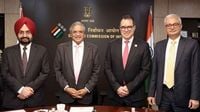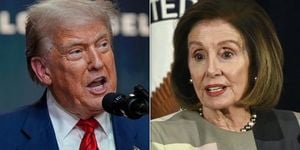India’s vast democracy is once again in the global spotlight as it navigates a complex web of election season challenges, technological innovations, and calls for greater transparency. With millions of voters heading to the polls across multiple states, the country’s election machinery is being tested in ways both familiar and unprecedented.
On November 3, 2025, Rahul Gandhi, leader of the opposition, took center stage in New Delhi, raising eyebrows with a provocative question: “What’s a Latin American hairdresser doing in a local election 9,000 miles away?” As reported by Hindustan Times, Gandhi displayed a series of electoral roll excerpts from a state poll held the previous year. The rolls showed 22 women, each with a different name—Seema, Sweety, Saraswati, and so on—but all bearing the same stock photo, which Gandhi identified as that of a Brazilian fashion model. The implication was clear: alleged irregularities in the voter rolls, raising concerns about the integrity of the electoral process.
Just a week later, on November 10, the chorus for transparency grew louder. Tejashwi Yadav, the Rashtriya Janata Dal (RJD) leader and Mahagathbandhan’s chief ministerial candidate for the Bihar Assembly Election, addressed reporters in Patna. According to NDTV, Yadav criticized the Election Commission of India (ECI) for delaying the release of voter turnout data from the first phase of polling, which had concluded on November 6. “The first phase of the elections was on November 6. Today is November 10. Even after 4 days, the data has not been made public... Earlier, they used to tell on the same day manually. Why is the data being concealed?” he demanded.
Yadav’s frustration didn’t stop there. He alleged a troubling nexus between the ECI and the ruling Bharatiya Janata Party (BJP), saying, “BJP will carry on with its sins and the Election Commission will keep covering... The Election Commission is dead and has become a tool...” Despite his criticisms, Yadav struck an optimistic note about Bihar’s future, outlining ambitious plans for food processing units, agro-based industries, better education and medical facilities, IT hubs, educational cities, and superspeciality hospitals. “We will make sure no Bihar has to go to other state,” he declared, underscoring his vision for a more developed Bihar.
Meanwhile, the state of Telangana was bracing for its own high-stakes contest. On November 11, 2025, the Jubilee Hills Assembly constituency in Hyderabad saw 4.01 lakh voters—2.08 lakh men and 1.92 lakh women—eligible to cast their ballots in a fiercely fought bypoll. According to The Hindu, 58 candidates were in the fray, though the real battle was among the ruling Congress, the BJP, and the Bharat Rashtra Samithi (BRS). The bypoll, necessitated by the death of BRS MLA Maganti Gopinath in June, was being closely watched as a referendum on Telangana Chief Minister A Revanth Reddy’s performance.
The stakes were high for all major parties. The Congress, hoping to consolidate its position, deployed not just the Chief Minister but all ministers for an intense campaign. The BJP, with ambitions for the 2028 assembly elections, fielded L Deepak Reddy, while BRS put forward Sunita, the late MLA’s widow. The presence of Asaduddin Owaisi-led AIMIM in support of the Congress added another layer of intrigue, especially given the constituency’s sizeable Muslim population—estimated at one lakh—who were expected to play a decisive role.
Security and transparency measures were ramped up to an unprecedented degree. Greater Hyderabad Municipal Corporation Commissioner R V Karnan, serving as District Election Officer, announced that 226 of the 407 polling stations had been declared “critical.” About 1,800 police officers and central security forces, including the CRPF at 68 locations, were deployed. For the first time, drone surveillance and web-casting were introduced at all polling stations, providing real-time monitoring and aerial analysis. “For the first time, drone surveillance is being deployed at all polling locations, for centralised aerial monitoring and real-time situation analysis,” stated an official release cited by The Hindu. Transportation of Electronic Voting Machines (EVMs) was monitored via GPS-fitted vehicles, and any faulty equipment was to be replaced instantly, as per ECI guidelines.
The administration also imposed a strict liquor ban: sales were prohibited from 6 PM on November 9 until 6 PM on polling day, and again from 6 AM on November 14 until counting was completed. Authorities conducted outreach in schools and community centers, urging first-time voters—especially those aged 18-19—to participate, underlining the importance of every single vote.
Amid these local and state-level dramas, the national election apparatus was engaging with the world. On November 10, Chief Election Commissioner (CEC) Gyanesh Kumar, along with election commissioners Sukhbir Singh Sandhu and Vivek Joshi, met with a delegation from the International Institute for Democracy & Electoral Assistance (IDEA) at the ECI’s New Delhi headquarters. This meeting followed Kumar’s keynote address at the Stockholm International Conference on Electoral Integrity in June, attended by over 100 participants from nearly 50 countries.
At the global forum, Kumar reaffirmed India’s commitment to electoral integrity and highlighted the scale of the operation. “Conducting elections with utmost integrity is a testament to our national resolve,” he stated, as reported by The Times of India. He noted that India’s elections are subject to scrutiny from parties, candidates, observers, media, and law enforcement—ensuring transparency akin to “concurrent audits at every stage.”
The numbers are staggering: over 20 million personnel are mobilized during general elections, with 979 million electors, more than 1.05 million polling stations, and 6.2 million EVMs used in the 2024 General Elections. The 2024 exercise featured 743 political parties and over 20,000 candidates. Tracing the evolution of India’s electoral process, Kumar said, “From 173 million electors in 1951-52 to 979 million in 2024, and from just 0.2 million polling stations in the early years to over 1.05 million today, India's electoral journey has demonstrated institutional foresight and unmatched scale.”
India’s electoral system is drawing international interest as well. On November 6, the day the first phase of Bihar assembly elections took place, CEC Kumar received a call from Mosotho Moepya, Chairperson of South Africa’s Electoral Commission. Moepya extended best wishes for the Bihar elections and revealed that South African parliamentarians plan to visit India soon to study its election management system, which is often hailed as one of the most transparent and efficient in the world.
As India’s election season unfolds, the nation finds itself at a crossroads—balancing the promise of technological advancement and global leadership in electoral management with persistent calls for transparency and accountability. The world watches closely as Indian voters, officials, and political leaders shape the outcome of the world’s largest democratic exercise.





